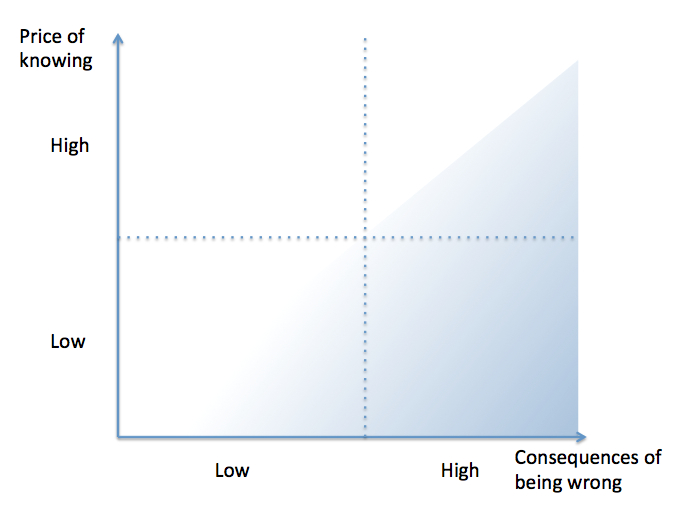Strategy for software Dummies – part 18
The title for this series of posts is inspired by the extensive series of instructional/reference books, which serve as non-intimidating guides for readers new to the various topics covered, or for readers who need a solid brush up. The title doesn’t imply that software CEO’s are Dummies; only that there is a need for a new type of “strategy framework” that produces more than fluff and which can be completed in a very short time.
This post discusses the cost/benefit ratio of ensuring alignment in the management team.
The cost of misalignment
I suppose we have all been in situations where we knew that the management team and thus the entire company was misaligned. I assume that we also have had the “feeling” that this misalignment had severe consequences such as:
- Lost business opportunities (sales)
- Winning poor deals (deals with negative gross margin and/or outside our core markets)
- High staff turnover
- Excessive operational cost
- Internal waste (time and money)
- Decreasing competitiveness
- Bankruptcy
Putting a specific number of the cost of misalignment is obviously very difficult.
Based on my experience the price of misalignment is ALWAYS EXTREMELY HIGH and accumulates dramatically over time. Ongoing misalignment eventually leads to the ultimate disaster: Bankruptcy.
In todays competitive environment only those software companies that understands how to align all resources to pursue a chosen strategy will survive.
The strategy – and associated plans and activities – may change from time to time based on the feedback signals from the market. The ability of the management team to intercept and interpret the signals, define corrective actions and realign quickly is crucial for becoming and maintaining a position as the market leader. In the software industry, where the winner takes all, global market leadership must be the objective of any company.
The cost of ensuring alignment
We have through this series of posts “Strategy for software Dummies” demonstrated how to check for misalignment. We still claim that a thorough check can be completed within two weeks and will cost little when using ValuePerform and a certified consultant to facilitate the process. Such check will document the degree of misalignment, identify the areas of misalignment and provide the basis for an action plan to assure alignment around the chosen strategy.
Implementing this action plan can be anything from simple to comprehensive.
We have seen situations where members of the management team needed to be replaced, because the misalignment was deeply rooted in differences in personal beliefs, preferences and values. And we have seen situations where just minor corrections yielded immediate results.
The cost/benefit ratio of ensuring alignment
Is this equations always true?
 I will claim it is and I suppose most executives will agree with me. The next question is then how to measure the current degree of alignment.
I will claim it is and I suppose most executives will agree with me. The next question is then how to measure the current degree of alignment.
A number of executives will be satisfied with presuming alignment. They a) genuinely “presume or feel” that they have alignment or b) don’t want any additional issues to deal with just now.
Presuming versus knowing
I once read a book based on the experiences of a CIA agent. One of the statements that had a lasting impression on me was something like this: “Presumptions will eventually kill you”.
 Making decisions, which may have an impact on wether you or others live or die, are certainly made substantially different form decisions with a less irreversible outcome. Nevertheless is it important to always be conscious about the difference between “knowing” and “presuming”.
Making decisions, which may have an impact on wether you or others live or die, are certainly made substantially different form decisions with a less irreversible outcome. Nevertheless is it important to always be conscious about the difference between “knowing” and “presuming”.
When the price of moving from “presuming” to “knowing” is minimal, there is no excuse for not doing so. When the consequences of being wrong are small you simply execute in small steps correcting the process as you learn more.
There is always a price associated with certainty. When that price is low compared to the consequences of being wrong there is never an excuse for not replacing “presuming” with “knowing”.
We know that checking for misalignment is not difficult, doesn’t take long and doesn’t cost a lot. We know that the consequences of being wrong are high.
What are you waiting for?
Previous posts in this series:
Post #1: Strategy? – oh no, not again!
Post #2: Introducing ValuePerform – a lean approach for strategy analysis and alignment
Post #3: The 6 sources for financial growth
Post #4: Why do management teams disagree?
Post #5: Getting the priorities in place
Post #6: The Customer Value Proposition
Post #7: The Customer Value Proposition TODAY
Post #8: The Customer Value Proposition in the FUTURE
Post #9: The Market Situation
Post #10: ValuePerform and the 15 Management Areas
Post #11: What is important and what is not?
Post #12: How are we performing?
Post #13: Identifying the important and the urgent issues
Post #14: The Action Plan
Post #15: Why does misalignment occur?
Post #16: The price of management misalignment
Post #17: Avoiding invisible or suppressed misalignment










